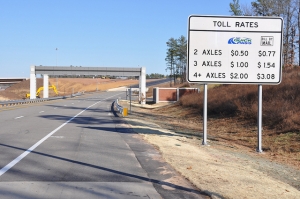

Photo by Mark Clifton is licensed under CC BY 2.0
It’s no secret that toll roads are unpopular with many Texans. Citizens and organized groups have been very vocal about their feelings. Texas legislators obviously heard them and responded. As a result, the state appropriated money for transportation projects but limited new funding to road projects without toll lanes.
That does not mean, however, that Texas won’t have more toll roads in the near future. The LBJ Freeway’s Westside Expansion just opened in Dallas-Fort Worth with toll lanes. Austin’s MoPAC Expressway, currently under construction, was planned for a toll lane in each direction from Central Austin to the northern part of the city. El Paso, too, has multiple toll projects planned along Loop 375.
The legislative provision that limited transportation funding to non-toll projects is causing public officials throughout the state to re-examine numerous planned projects. The concern by many is that projects already planned with toll lanes may get “leapfrogged” by other lower-priority projects simply because they don’t have tolls attached to them.
Some transportation officials have suggested that it might be possible to construct toll lanes on new road projects if alternative funding is used. The same roadway, for instance, might use state funding for regular lanes and other funding (perhaps federal) for tolled lanes. But, that possibility has not moved beyond the “pondering period.”
Historically, road projects have been funded by state gasoline taxes. But, because that particular tax has not increased since 1991, that source of funding has become woefully inadequate.
About five years ago, the Texas Department of Transportation (TxDOT) announced that it no longer had adequate funding to build new roads. According to Michael Morris, transportation director of the North Central Texas Council of Governments, “TxDOT essentially had to get out of the capacity business and get into the maintenance business.”
Numerous other transportation organizations throughout Texas resorted to toll roads and the revenue they provide to finance road projects. That solution worked, but complaints were prevalent.
In 2014, voters approved Proposition 1, which funneled oil and gas production tax revenue (over a certain threshold) from the Rainy Day Fund to the State Highway Fund. And, in November, voters have an opportunity to send an additional $3 billion of the general sales tax, as well as a portion of vehicle sales taxes, to the same transportation fund. That money would then be added to about $1.3 billion in gas tax revenue that had previously been diverted from the State Highway Fund to other parts of the budget.
If voters approve the action, transportation planners will have about $5 billion annually to fund projects. However, TxDOT has repeatedly stated that it needs at least $7 billion – $3 billion to add capacity, $1 billion for maintenance, $1 billion in energy-related expenses and $3-4 billion for projects originally committed to tolled projects.
Bottom line – even if all the new funding materializes, it will still be considerably short of what’s needed.
No one can say for sure what will happen to future toll lanes in Texas. If they are no longer an option, and if other funding comes in at least several billion short of what is needed, a serious problem exists. One has to wonder what transportation officials are supposed to do then.
Tolled lanes have definitely eliminated some of the state’s dreaded traffic congestion. And, drivers who elect to use and pay for faster-moving traffic lanes create much-needed funding for maintaining the state’s most traveled roads. The economic prosperity that the state is currently enjoying could be reversed if our transportation infrastructure becomes inadequate. It’s definitely something to consider.
Whatever happens, SPI team members will be on top of the situation and will be able to guide clients through the maze of governmental affairs.
